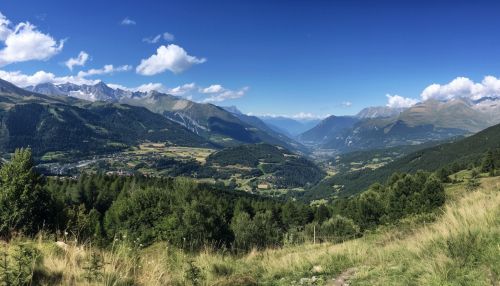Haute-Savoie
Geography and Topography


Haute-Savoie is a department in the Auvergne-Rhône-Alpes region of southeastern France. It is bordered by Switzerland to the north, Italy to the east, and the French departments of Ain and Savoie to the west and south, respectively. The department is characterized by its diverse topography, which includes the Alpine mountain range, lush valleys, and numerous lakes. The highest point in Haute-Savoie is Mont Blanc, which stands at 4,808 meters and is the highest mountain in Western Europe.
The department is divided into four arrondissements: Annecy, Bonneville, Saint-Julien-en-Genevois, and Thonon-les-Bains. Each arrondissement is further subdivided into cantons and communes. The capital of Haute-Savoie is Annecy, known for its picturesque old town and the pristine Lake Annecy.
Climate
Haute-Savoie experiences a varied climate due to its diverse topography. The lower valleys and areas near Lake Geneva have a temperate climate with mild winters and warm summers. In contrast, the higher altitudes experience a mountain climate, characterized by cold winters with heavy snowfall and cool summers. The department receives substantial precipitation throughout the year, which contributes to its lush vegetation and numerous water bodies.
Natural Resources and Environment
The department is rich in natural resources, including forests, water bodies, and mineral deposits. The forests of Haute-Savoie are predominantly composed of coniferous trees such as spruce, fir, and pine, as well as deciduous species like beech and oak. These forests provide habitat for a variety of wildlife, including deer, chamois, and marmots.
The numerous lakes and rivers in Haute-Savoie are vital for both the ecosystem and the local economy. Lake Geneva, the largest lake in Western Europe, forms part of the department's northern border. Other significant water bodies include Lake Annecy, Lake Bourget, and the Arve River. These water bodies support a range of aquatic species and are popular destinations for recreational activities such as boating, fishing, and swimming.
Economy
The economy of Haute-Savoie is diverse, with key sectors including tourism, agriculture, and industry. The department's scenic landscapes and outdoor recreational opportunities make it a popular destination for tourists, particularly for skiing, hiking, and mountaineering. The ski resorts of Chamonix, Megève, and La Clusaz are among the most renowned in the region.
Agriculture in Haute-Savoie is characterized by dairy farming, livestock rearing, and the cultivation of crops such as maize, wheat, and potatoes. The department is also known for its production of high-quality cheeses, including Reblochon, Tomme de Savoie, and Abondance.
The industrial sector in Haute-Savoie is diverse, with significant contributions from the precision engineering, electronics, and pharmaceuticals industries. The department is home to several high-tech companies and research institutions, particularly in the areas of microtechnology and biotechnology.
History
The history of Haute-Savoie is rich and complex, with evidence of human habitation dating back to prehistoric times. The region was originally inhabited by the Allobroges, a Celtic tribe, before being conquered by the Romans in the 2nd century BCE. During the Roman period, the area was part of the province of Gallia Narbonensis.
In the medieval period, Haute-Savoie was part of the Kingdom of Burgundy before becoming a territory of the House of Savoy in the 11th century. The region remained under Savoyard control until the Treaty of Turin in 1860, when it was ceded to France as part of the unification of Italy.
Culture and Heritage
Haute-Savoie has a rich cultural heritage, influenced by its historical ties to the House of Savoy and its geographical proximity to Switzerland and Italy. The department is known for its traditional Savoyard architecture, characterized by wooden chalets with steeply pitched roofs and intricate carvings.
The local cuisine is another important aspect of Haute-Savoie's cultural heritage. Traditional dishes include fondue, raclette, and tartiflette, all of which feature local cheeses and other regional ingredients. The department also has a strong tradition of winemaking, with vineyards producing wines such as Roussette de Savoie and Seyssel.
Demographics
As of the latest census, Haute-Savoie has a population of approximately 850,000 residents. The population is diverse, with a mix of urban and rural communities. The largest cities in the department are Annecy, Thonon-les-Bains, and Annemasse. The population density varies significantly, with higher concentrations in the urban areas and lower densities in the mountainous regions.
Transportation
Haute-Savoie is well-connected by a network of roads, railways, and airports. The A40 and A41 motorways provide access to major cities such as Geneva, Lyon, and Grenoble. The department is also served by several regional and high-speed train lines, including the TGV, which connects Annecy to Paris in approximately four hours.
The nearest international airport is Geneva Airport, located just across the border in Switzerland. The airport provides flights to numerous destinations worldwide and is a major hub for both passenger and cargo traffic. Additionally, the department has several smaller airports and airfields that cater to domestic and regional flights.
Education and Research
Haute-Savoie has a well-developed education system, with numerous primary and secondary schools, as well as several higher education institutions. The University of Savoie Mont Blanc, with campuses in Annecy and Le Bourget-du-Lac, offers a wide range of undergraduate and postgraduate programs in fields such as engineering, business, and the humanities.
The department is also home to several research institutions and centers of excellence, particularly in the areas of environmental science, renewable energy, and medical research. These institutions collaborate with both national and international partners to advance scientific knowledge and innovation.
See Also
- Alps
- Lake Annecy
- Microtechnology
- Biotechnology
- Environmental science
- Renewable energy
- Medical research
